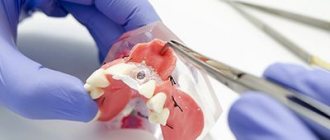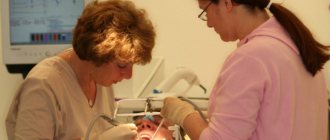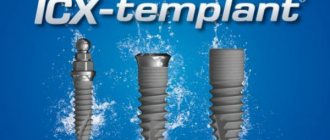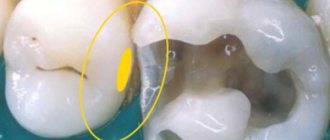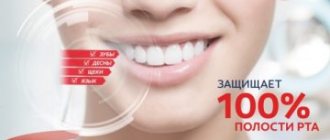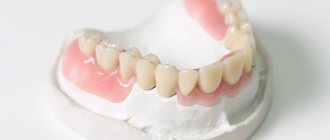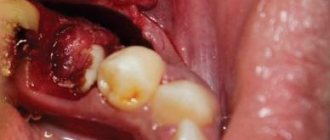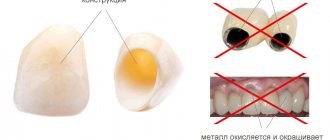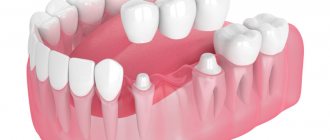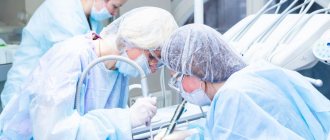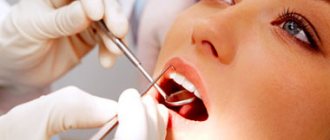4121
It is still believed that the best implants for bone surgery are autogenous (taken from the patient himself) bone. However, due to its limited nature and pronounced resorption, this material still cannot be considered ideal.
A good alternative is bone substitutes obtained from animal bones. The Bio Oss biomaterial produced by Geistlich Pharma, intended for use in dentistry, contains all the main advantages of bone substitutes.
General overview
Bio Oss is obtained from cattle bones. The material has several dosage forms, allowing you to choose the optimal method of delivery to the surgical wound:
- Granules packaged in bottles (Bio-Oss Spongiosa). Universal form, suitable for any type of operation.
- Granules in a syringe (Bio-Oss Pen). Thanks to the specially shaped tip, Bio-Oss Pen is especially convenient in cases where the operating area is in a hard-to-reach place.
- Blocks (Bio-Oss Block). Used when filling significant defects is required.
- Combined preparation Bio-Oss Collagen, 90% consisting of Bio-Oss granules, 10% porcine collagen. Thanks to the latter, it has increased adhesive, manipulation and regenerative properties.
Geistlich Pharma also produces Geistlich Bio-Gide Membrane, an auxiliary material used to create a barrier between the bone and the sinus. The use of Bio-Gide accelerates tissue regeneration and wound healing.
Geistlich Bio-Oss is recommended for use in all types of bone grafting - in dental surgery, implantology, periodontology, and maxillofacial surgery.
In terms of its regenerating and healing properties, it is not only comparable to autogenous bone grafts, but in individual components it is superior to them.
Besides:
- Bio-Oss can be used alone or in combination with autogenous bone.
- Bone substitute effectively stabilizes the blood clot, preventing alveolar bleeding.
- High hydrophilicity, caused by the presence of many micro- and macropores, promotes uniform and rapid impregnation of the material with saline solution and the patient’s blood.
- Stability and preservation of the volume of the resulting bone tissue is a winning point from the point of view of ensuring the aesthetics of facial tissue.
- The multiplicity of forms and good handling characteristics make it possible to use Bio-Oss in a wide variety of clinical cases, including complex ones.
The technique for using Bio-Oss depends on the clinical situation and the dosage form used. The following points are common:
- Soaking the material with saline solution or the patient’s blood.
- It is supplied to the operation area and distributed over the defect.
- Closure of the surgical wound with a flap of the patient's soft tissue, followed by suturing and/or application of a Bio-Gide membrane.
Let’s find out together how long the temperature lasts after dental implantation, and in what cases the help of specialists is needed.
Come here if you are interested in the benefits of dental implants.
At this address https://www.vash-dentist.ru/implantatsiya/metodiki/o-prieme-antibiotikov-posle-zubov.html we will tell you why antibiotics are prescribed after dental implantation.
Comparison of Collagen and Block cytotoxicity
As a result of medical research, it was revealed that Bio-Oss collagen has mild cytotoxic properties. This is another important point, since the cytotoxic mechanism is aimed at destroying foreign agents: protozoan microorganisms, viruses and bacteria. In this regard, the drug is not recommended for use in patients with infectious diseases. These include damage to the body by viruses, bacteria, helminths and protozoan microorganisms. If you suffer from acute viral illnesses, tell your doctor.
If bone replacement material must be placed urgently, an alternative option, Bio-Oss Pen, can be used. Before injecting the product into the bone, the patient should consult a specialist and undergo a full medical examination. This will help avoid possible side effects and serious consequences.
Indications and contraindications
In orthopedics, Bio Oss is recommended for use in all cases where it is necessary to maintain or increase the volume of the bone of the alveolar process or jaw:
- Filling the hole after tooth extraction to maintain the normal volume of bone tissue if implantation is planned in the future.
- Bone augmentation , performed simultaneously with tooth implantation to fill the gaps between the bone and the implant.
- Filling fenestrations and dehiscences (discrepancies and holes) in the bone after implant placement.
- Sinus lift.
- Filling cavities in the bone tissue of the jaw or alveoli formed as a result of cystectomy.
Due to the affinity of Bio Oss with human bone tissue, the biomaterial has virtually no contraindications. The only limitation is that it cannot be used to fill infected wounds.
Dental implant technology
Implant prosthetics consists of implanting an implant (artificial root) into the jaw bone, into which an abutment is installed, onto which a crown is subsequently installed.
Implants can be used for all types of prosthetics. Dentures are divided into two main groups: removable and non-removable. Dentures on implants can replace defects in the dentition of any extent. With the help of implant prosthetics, removable dentures can be replaced with fixed ones. or better fixation of a removable denture can be ensured.
Advantages of prosthetics on implants
The positive aspect of this type of prosthetics is:
- no trauma to a healthy tooth.
- An implant fully replaces a natural tooth and often surpasses it in stability, so prosthetics on implants ensures a strong and reliable fixation of the prosthesis in the oral cavity.
To make a decision on the possibility and advisability of installing an implant for a particular patient, doctors at our clinic must conduct additional studies: ORT-orthopantomogram (image of the entire oral cavity) and CT (computed tomography) with 3D modeling of the jaw area where the implant will be installed. This study allows you to reconstruct the desired area on a computer to accurately measure not only the height, but also the thickness of the bone. Based on the results of this study, a decision is made on the feasibility and necessity of bone grafting.
Bone grafting
Bone grafting is the correction of bone defects through bone grafting. This procedure becomes necessary in a situation where there is not enough bone tissue in the patient’s jawbone for implantation.
In different patients, jawbone atrophy can occur for various reasons: trauma, heavy chewing load, a long period between tooth extraction and implant installation, or specific body structure.
In order for the implant to be installed efficiently and for many years, it must be completely immersed in the jaw bone, which previously contained the removed or fallen out tooth. But after a tooth is removed, the bone in which it was embedded atrophies, dissolves, the volume of bone tissue changes, and this can create significant difficulties during implantation and even make it impossible.
Research results show that bone grafting is necessary in 40% of dental implant cases. And since the smallest bone volume is in the center of the upper jaw, it is often there (when the bone height is less than 3 mm) that bone grafting is necessary. Bone grafting of the upper jaw is also known as sinus lifting (from the Latin sinus - upper jaw; English lift - lift). When carrying out such an operation, a very serious approach, experience and professionalism are required.
Bone grafting is performed under local anesthesia using various technologies of anesthesia and medicated sleep. Currently, the field of bone grafting is developing very quickly. This is facilitated by both the development of science and technology, as well as the constant increase in patient demands for the quality of dental treatment.
What is Bio-Oss and Bio-Gide?
Bio-Oss and Bio-Gide are materials of natural origin. Due to their high affinity to human tissue, these materials are ideal for promoting new bone formation and soft tissue healing. They integrate into human tissue during the healing process. This process can take several years for Bio-Oss, while Bio-Gide is fully integrated in a few months. Bio-Oss is produced from the mineral bones of Australian cattle. During the production process, organic components are removed, and the structure of bone tissue, consisting of calcium compounds, is preserved.
Contraindications to bone grafting
It is necessary to remember about contraindications to bone grafting. These include:
- various blood diseases
- diseases of the central nervous system
- diseases of internal organs
- cardiovascular and cancer diseases
- tuberculosis, AIDS, diabetes, etc.
After drawing up a plan of all necessary measures and making a decision by the patient, the surgeon, together with the orthopedist, determines the necessary design. For maximum accuracy and quality of this type of prosthetics, the computer calculates and simulates the location and direction of implant installation. Next, based on these calculations, a surgical template is made, with the help of which the surgeon performs the operation.
0
Physico-chemical characteristics
Animal bones consist of 25% organic matter (collagen), 65% inorganic matter (calcium phosphate) and 10% water.
Organic matter other than collagen is present in small quantities - lipids, polysaccharides, proteins. In addition to calcium, there are ions of some other elements.
During the production of Bio-Oss, the organic component is removed from raw materials (cattle bones). All that remains is the mineral base (calcium phosphate), abundantly permeated with microcapillaries and microtunnels.
In its morphology, chemical composition and ultrastructure, Bio-Oss is very close to human bone, which determines the patient’s body’s positive reaction to it. Compared to other natural materials that have larger crystals, Bio-Oss integrates very well with native bone .
The topography of their surface is important for implanted biomaterials. Smooth materials integrate less well than rough ones. Bio-Oss has a pronounced rough surface , which promotes active adhesion and proliferation of osteoblasts and rapid matrix synthesis.
The area of the internal surfaces of the implant material is no less important. The larger it is, the more intensely the blood vessels grow into it, the more active and faster the integration and healing of wounds takes place. Histomorphometric studies carried out on 12 samples of bone materials showed that the internal surface of Geistlich Bio-Oss is about 80 m2/g, which is approximately 5 times greater than that of the other samples studied.
10% Collagen = Versatility
Thanks to its impressive characteristics and ability to adapt the material to the morphology of the defect, Geistlich Bio-Oss Collagen® is indicated in the following therapeutic areas:
- Removal of a tooth
- Augmentation
- Sinus lift
- Periodontal regeneration
- Reimplantation
For specific clinical indications where a barrier function is required, Geistlich Bio-Gide® is a natural companion to Geistlich Bio-Oss Collagen®.
Safety
Biomaterial obtained from cattle bones may contain prions, special infectious agents that can cause dangerous diseases in animals and humans. The first have “mad cow disease” (TSE, spongiform encephalopathy).
People are at risk of getting Creutzfeldt-Jakob syndrome, kuru and some other types of infections.
The safety of the Bio Oss biomaterial is ensured by two factors - the high quality of raw materials and processing technology, which involves multi-stage cleaning and sterilization.
When choosing raw materials, the country of origin is taken into account in terms of the effectiveness of veterinary control and precautionary measures taken against “mad cow disease”.
Geistlich Pharma purchases bone raw materials for Bio-Oss in the USA, where veterinary control is very effective. So far, not a single case of spongiform encephalopathy has been recorded.
To further guarantee safety, raw materials are obtained only from 3 slaughterhouses under constant USDA supervision.
The second factor ensuring the safety of the material is the multi-stage purification of raw materials aimed at inactivating prions. The bones are exposed to temperature for at least 15 hours.
Additionally, chemical purification of raw materials with alkaline compounds and treatment with gamma irradiation are carried out. This technology guarantees the complete safety of the biomaterial.
Benefits of Bio-Oss
The product is safe for the human body. This material has many advantages:
- High hydrophilic properties. Penetrating into the body, the drug is quickly absorbed by the blood. Such properties are possible due to the pores located on the surface of the granules.
- Product compatibility with human bone. The granules reach the newly formed bone and connect with it, forming a strong and reliable frame. This helps speed up the process of tissue repair without harm to the body.
- Low rate of resorption. Unlike other products of this type, Bio-Oss disintegrates slowly, due to which it has a long-lasting effect on the bone, promoting its regeneration.
- Safety. The product is a biofunctional material and can therefore be used to treat a wide range of musculoskeletal diseases.
The Bio-Oss material can be used alone or in combination with another osteoplastic element—autologous bone. The bone replacement material is implanted into natural tissue within 3 months. The product can be purchased at a price of no less than 6,000 rubles.
Biological properties
Osteoplastic materials are divided into three groups:
- osteoinductive , directly affecting the formation and growth of bone tissue;
- osteoconductive - play the role of a bone frame on which new bone tissue is formed;
- osteoneutral , acting as a bone filler.
Bio Oss belongs to osteoconductive biomaterials, i.e. it functions as a scaffold on which new bone tissue is formed and differentiated.
The high osteoconductive properties of the material are determined by the large internal surface area, high absorption of proteins and the activity of heterodimeric proteins (integrins), which ensure cell adhesion to the matrix.
The microstructure is characterized by the presence of large free internal space. This makes the material an optimal scaffold for newly formed bone tissue.
After the operation, rapid and deep growth of blood vessels into the implanted material occurs, trophism is activated, and osteoblasts, young bone tissue cells involved in matrix synthesis, actively migrate from the patient’s tissues to the defect area. Further, during the regeneration process, osteoblasts are transformed into osteocytes - mature bone tissue.
On what day are sutures removed after dental implantation and the reasons for their separation.
This article provides detailed information about anterior dental implants.
Here https://www.vash-dentist.ru/implantatsiya/metodiki/o-sdache-analizov-pered-zubov.html read what tests you need to take before dental implantation.
Main advantages
Bio oss bone material has been successfully used by leading dentists for many years, in particular, by specialists at the A-Medic clinic. Its advantages include:
- blood clot stabilization;
- slow resorption of granules (it makes it possible to maintain the volume of the augmentation over a long period of time);
- high hydrophilicity. It is ensured by a unique system of macro and micro pores, which guarantee uniform saturation of the granules with blood;
- osteoconductive properties. They are a guarantee of reliable regeneration. The granules are integrated into the formed bone and become its frame;
- guarantee of soft tissue aesthetics. This is due to the formation of a high-quality base of hard tissue.
Expected effect of application
The high integration of Bio-Oss with native bone tissue has been established by numerous histological studies. It was noted that already 15 days after surgery, osteoblasts formed mature collagen fibers on Bio-Oss.
It took about 6 weeks to form an extensive matrix network - collagen fibers woven into the biomaterial frame. Histological sections revealed organic substances that regenerated independently inside the implantation tissue or got there from the patient’s blood.
Thanks to its slow resorption, Bio-Oss serves as a stable scaffold for regenerating tissue and slows down the resorption of the graft. Studies have found that implantation material made from a mixture of substitute and native bone is more stable than implants in which autogenous bone chips are used as the only component.
In the case of the use of Bio-Oss, constancy of bone volume was noted throughout the observation , while the use of one autogenous material was accompanied by a decrease in the volume of implant material.
Histomorphometric analysis of tissues subjected to restoration using Bio-Oss showed that the volume of the mineral component in the regenerated bone is higher than in native bone tissue.
This may explain the high stability of implants containing Bio-Oss in combination with autogenous bone.
The adhesion strength of implants in the sinuses after sinus lift was also studied. It was found that 3 months after surgery, materials with Bio-Oss had 45% greater fixation strength than implants made from autogenous bone.
The video provides instructions on how to use the material.
Characteristics of Bio Oss
The composition of animal bones is 25% collagen, 65% calcium phosphate, 10% water. Lipids, proteins and polysaccharides are present in small quantities. There are ions of calcium and other elements.
During the manufacturing process of a medicine, organic elements are removed from raw materials. Only the mineral base, penetrated by a capillary network, is left.
The chemical composition, structure and morphology of Bio Oss are almost identical to human bone. This determines the body’s positive reaction to the introduction of the composition. The material integrates perfectly with the native bone.
The bone substitute is distinguished by a pronounced rough surface that promotes active adhesion, proliferation of osteoblasts and accelerated matrix synthesis.
The internal surface of Bio-Oss reaches 80 m2/g. Due to this, intensive ingrowth of blood vessels into the implantation material and accelerated integration are observed.
Safety
Biomaterial made from cattle bones may contain prions - infectious agents that can provoke dangerous diseases: Creutzfeldt-Jakob syndrome, kuru and other types of infection.
The safety of Bio-Oss is ensured by high-quality raw materials and strict adherence to processing technologies. Raw materials undergo multi-stage cleaning and sterilization. The material is exposed to temperature for 15 hours and undergoes chemical cleaning.
When choosing raw materials, manufacturers take into account the country of origin. The effectiveness of veterinary control and precautionary measures aimed at combating the spread of “mad cow disease” are taken into account.
Geistlich Pharma purchases bone raw materials in the USA, where strict veterinary controls are in place. To date, no cases of spongiform encephalopathy have been recorded.
For added safety, raw materials are collected only from three USDA-monitored slaughterhouses.
Biological properties
There are three groups of osteoplastic materials:
- osteoinductive - affect bone formation and growth;
- osteoconductive - act as a frame on which new bone tissue is formed;
- osteoneutral - bone filler.
Bio Oss is part of the group of oteoconductive materials. The osteoconductive properties of the biomaterial are due to the large internal surface area, increased protein absorption and integrin activity.
The microstructure of the composition is distinguished by its extensive internal space. Thanks to this, Bio Oss is an ideal scaffold for newly formed bone tissue.
Result of application
Numerous histological studies revealed that already 5 days after surgery, osteoblasts created mature collagen fibers on Bio-Oss. After six weeks, the formation of an extensive matrix network was observed.
Due to slow resorption, the biomaterial forms a reliable framework for regenerating tissue. It has been proven that implant material made from a combination of native bone and substitute demonstrates high stability.
The adhesion strength of Bio Oss implants in the sinuses after sinus lift three months after surgery is 45% higher than that of implants made from autogenous bone tissue.
Prospects
Today, bone transplantation mainly uses autogenous materials and PRP (platelet-rich plasma). The latter is a gel containing blood plasma and platelets, which play a major role in tissue regeneration and healing.
Apparently, the time is not far when surgeons will have autogenous biomaterials grown outside the body at their disposal.
However, for any implantation materials, regardless of their origin, a carrier is required that ensures effective tissue regeneration and meets a number of requirements, including:
- high cell adhesion;
- saving space;
- positive effect on bone morphology;
- support cell differentiation.
And from this point of view, bone substitutes like Bio-Oss, capable of working together with PRP, can be considered as very promising materials.
Bio-Gide Collagen Membrane
Bio-Gide is the standard collagen membrane for the restoration of soft tissue and bone after dental surgery. This is a highly purified natural product that contains pork collagen. Soft tissues contain a large amount of collagen fibers, so the collagen membrane is used in the restoration of bone and periodontal tissue. The use of Bio-Gide helps the surgeon achieve the best and most predictable results and provides excellent wound healing. Bio-Gide has high therapeutic safety, which is highly valued by all leading surgeons.
The excellent qualities of Bio-Gide are achieved thanks to its three-dimensional, natural matrix structure and high biocompatibility. The structure of the Bio-Gide membrane is very similar to human collagen. The photo above shows human collagen under a microscope and below is the Bio-Gide membrane. The natural structure of collagen helps in the healing process - blood vessels grow through the collagen fibers.
The membrane performs several important functions in the regeneration process: protective, stabilizing, and is the basis for soft tissues.
Bio-Gide membrane has a two-layer structure, one side is smooth and the other is rough. The smooth top layer guides soft tissue healing, which occurs more easily and with better aesthetic results. The rough side of the Bio-Gide membrane helps growing bone cells.
There is no need to remove the membrane. The breakdown of the membrane into natural amino acids occurs without side effects, without tissue irritation.
conclusions
The use of natural biomaterials in maxillofacial surgery is becoming increasingly popular. Their developed internal surface has a positive effect on the adhesion and differentiation of cells in the defect area.
Low resorbability increases volume stability. The natural structure of the carriers, close to human ones, creates favorable conditions for the regeneration of new bones. All this promises materials like Bio-Oss to be in high demand in surgery.
If you find an error, please select a piece of text and press Ctrl+Enter.
Tags bone materials
Did you like the article? stay tuned
Previous article
Root canal obturation – prolonging the life and full functions of the tooth
Next article
When is the use of the Persin apparatus for the correction of malocclusions justified?
Features of surgery
Typically, bone restoration and implant placement are performed simultaneously. To form new bone, the defect is filled with Bio-Oss biomaterial, and for directed regeneration, a Bio-Hide membrane is applied to the wound.
After surgery, slight swelling and swelling may occur, which can be eliminated with a cold compress. During the first 10-14 days, while brushing your teeth, you should avoid trauma to the operated area and use an antibacterial rinse. If severe pain occurs, the doctor may prescribe a pain reliever. At the same time, it is important to regularly see a dentist, even if nothing is bothering you and healing is proceeding well.
Recommendations
- Jung RE et al., Postextraction tissue management: the soft tissue punch method, Int J Periodontics Restorative Dent 2004; 24 (6): 545-553
- Araujo MG et al., Dynamics Geistlich Bio-Oss Collagen® incorporating fresh wounds for extraction: a pilot study in a dog, Clin Oral Implants Res 2010; 21(1):55-64
- Nevins ML et al., Three-dimensional microcomputed tomographic assessment of periodontal regeneration: a report of intravascular defects processed by BOC, Int J Periodontics Restorative Dent 2005; 25 (4): 365-373
- Nevins ML et al., Evaluation of renal rheology after intrazonal defect grafting with Bio-Oss Collagen®: a human histological report, Int J Periodontics Restorative Dent 2003; 23(1):9-17
- Araujo MG, Linder E et al., Bio-Oss Collagen® in the buccal cleft for direct implants: a 6-month study in a dog, Clin Oral Implants Res 2011; 22(1):1-8
- Heinemann F, Hasan I et al., Bone level modification in extraction sockets with Bio-Oss Collagen® and implant placement: a clinical study, Ann Anat 2012; 194(6):508-12
Documented: Over 1000 publications Reliable: Over 29 years of clinical experience Verified: 163 years Geistlich collagen competence
